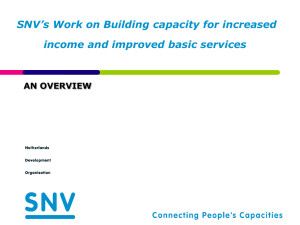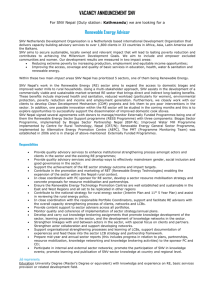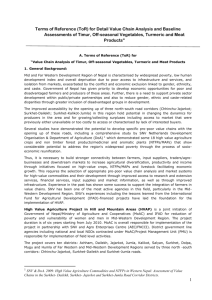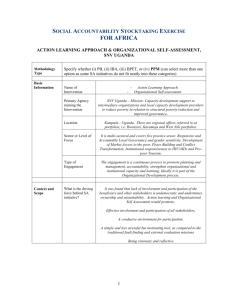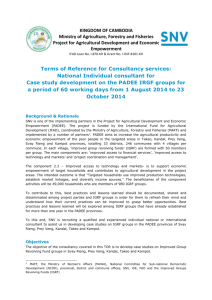tor-b_1313732127
advertisement
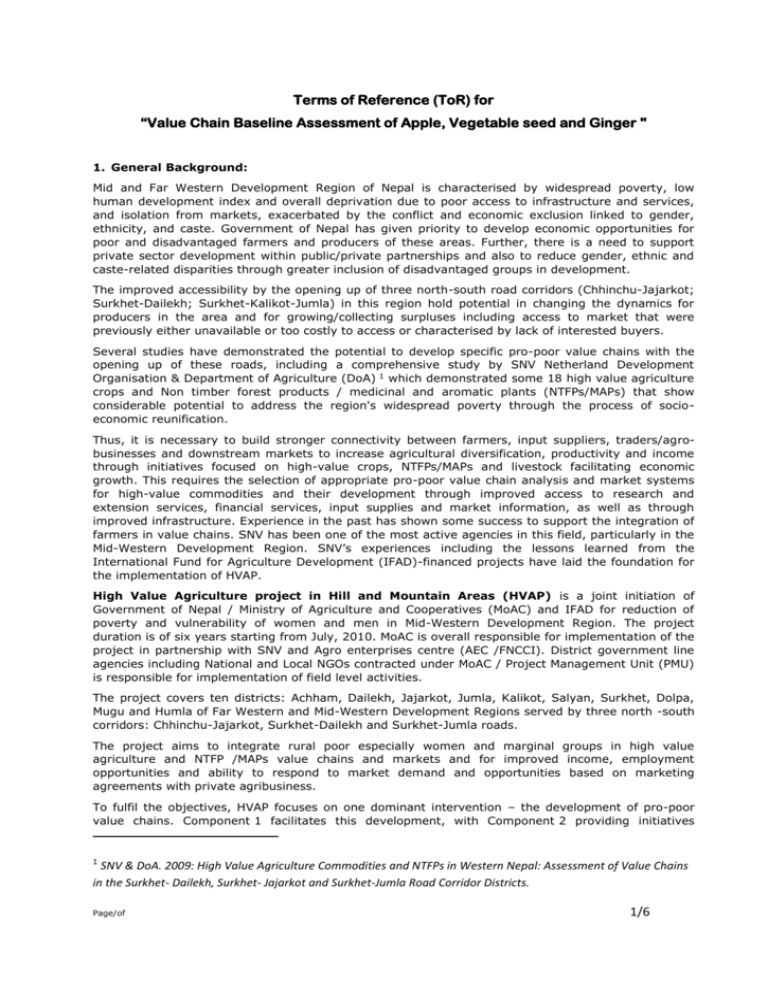
Terms of Reference (ToR) for “Value Chain Baseline Assessment of Apple, Vegetable seed and Ginger " 1. General Background: Mid and Far Western Development Region of Nepal is characterised by widespread poverty, low human development index and overall deprivation due to poor access to infrastructure and services, and isolation from markets, exacerbated by the conflict and economic exclusion linked to gender, ethnicity, and caste. Government of Nepal has given priority to develop economic opportunities for poor and disadvantaged farmers and producers of these areas. Further, there is a need to support private sector development within public/private partnerships and also to reduce gender, ethnic and caste-related disparities through greater inclusion of disadvantaged groups in development. The improved accessibility by the opening up of three north-south road corridors (Chhinchu-Jajarkot; Surkhet-Dailekh; Surkhet-Kalikot-Jumla) in this region hold potential in changing the dynamics for producers in the area and for growing/collecting surpluses including access to market that were previously either unavailable or too costly to access or characterised by lack of interested buyers. Several studies have demonstrated the potential to develop specific pro-poor value chains with the opening up of these roads, including a comprehensive study by SNV Netherland Development Organisation & Department of Agriculture (DoA) 1 which demonstrated some 18 high value agriculture crops and Non timber forest products / medicinal and aromatic plants (NTFPs/MAPs) that show considerable potential to address the region's widespread poverty through the process of socioeconomic reunification. Thus, it is necessary to build stronger connectivity between farmers, input suppliers, traders/agrobusinesses and downstream markets to increase agricultural diversification, productivity and income through initiatives focused on high-value crops, NTFPs/MAPs and livestock facilitating economic growth. This requires the selection of appropriate pro-poor value chain analysis and market systems for high-value commodities and their development through improved access to research and extension services, financial services, input supplies and market information, as well as through improved infrastructure. Experience in the past has shown some success to support the integration of farmers in value chains. SNV has been one of the most active agencies in this field, particularly in the Mid-Western Development Region. SNV’s experiences including the lessons learned from the International Fund for Agriculture Development (IFAD)-financed projects have laid the foundation for the implementation of HVAP. High Value Agriculture project in Hill and Mountain Areas (HVAP) is a joint initiation of Government of Nepal / Ministry of Agriculture and Cooperatives (MoAC) and IFAD for reduction of poverty and vulnerability of women and men in Mid-Western Development Region. The project duration is of six years starting from July, 2010. MoAC is overall responsible for implementation of the project in partnership with SNV and Agro enterprises centre (AEC /FNCCI). District government line agencies including National and Local NGOs contracted under MoAC / Project Management Unit (PMU) is responsible for implementation of field level activities. The project covers ten districts: Achham, Dailekh, Jajarkot, Jumla, Kalikot, Salyan, Surkhet, Dolpa, Mugu and Humla of Far Western and Mid-Western Development Regions served by three north -south corridors: Chhinchu-Jajarkot, Surkhet-Dailekh and Surkhet-Jumla roads. The project aims to integrate rural poor especially women and marginal groups in high value agriculture and NTFP /MAPs value chains and markets and for improved income, employment opportunities and ability to respond to market demand and opportunities based on marketing agreements with private agribusiness. To fulfil the objectives, HVAP focuses on one dominant intervention – the development of pro-poor value chains. Component 1 facilitates this development, with Component 2 providing initiatives 1 SNV & DoA. 2009: High Value Agriculture Commodities and NTFPs in Western Nepal: Assessment of Value Chains in the Surkhet- Dailekh, Surkhet- Jajarkot and Surkhet-Jumla Road Corridor Districts. Page/of 1/6 directly in support of value chain development: formation/strengthening value chain producers groups, initiatives to promote gender and social inclusion, support for high value commodity production and post-harvest activities, establishment of a grant-based value chain development fund, and support for district operations and inclusion of remote communities. Component 3 provides for project management and linked activities including M & E and knowledge management. The project follows Inclusive Business and Value Chain Development approach in the geographic boundries demarcated by accessibility to roads rather than the existing political boundries. The demand driven nature of the project demands the project to engage with agribusiness companies to integrate poor producers in their supply chain. SNV Netherlands Development Organisation-an international development organisation that provides advisory services for capacity strengthening of the local organisations working in various developing countries including Nepal is providing technical assistance to HVAP. As an implementing partner and a technical support provider, SNV is responsible for the implementation of component 1 Pro poor value chain development with AEC. Besides, SNV will support for coordination of activities in component 2 and for knowledge management, part of Component 3. SNV has made a strong commitment to engage Local Capacity Builders (LCBs) in all sectors as per SNV Corporate Strategy (2007-2015). The purpose of LCB engagement is to respond to the scale and complexities of development challenges with the innovation, increased coverage and more sustainable local capacity of LCBs which can replace SNV’s direct services more efficiently and effectively. Keeping in view of HVAP’s engagement, SNV conducted detail value chain analyses of apple, vegetable seed and ginger. Now, HVAP is about to undertake similar studies for timur, goat meat, turmeric and off season vegetables. The VCAs so far undertaken have identified key constraints and opportunities and recommended key action points to overcome those constraints and leverage the opportunities to promote the selected value chains for inclusive & sustainable pro poor economic growth. Prior implementing those action points, it is deemed essential to esbalish baselines of those value chains on VC actors, potential target groups, production pockets, socio-economic and poverty / gender / socially and economically marginalised group mapping within the project intervention area along the road corridors. Accordingly, HVAP has planned to undertake baseline studies of above mentioned 3 value chains, the results of which will serve as bench mark for monitoring and evaluating project outcomes in specific value chain at different levels. Moreover, information obtained from the baseline will be useful for project planning and ultimately help in fostering pro poor value chain development. 2. Objective The major objective of the assignment is to establish baseline for the selected value chains as Apple, Ginger and Vegetable seed. The study is expected to provide sufficient quantitative and qualitative details on the current production, processing, marketing and actors involved in all stages of the value chains. The specific objectives of the survey include: Development and administration of baseline instrument: Develop a survey instrument and collect baseline information at each nodes of the value chains so as to enable the project to measure progress, outcomes and impacts. Quantify the VC actors and service providers in particular producers (small and large), middlemen, processor, and traders (and their associations/ organisations if any). Quantify production volume, productivity, sales volume, added value, gross margin, actual benefits and income generated at different levels of value chain. Generate data on infrastructure facilitating production and marketing (irrigation, gravity rope way, rural roads, culvert, market shed, collection centre including distance of nearest market / collection centre etc.) VC impacts: Contribution of the value chains in household income, jobs creation, and other social, economic, and environmental impacts of the value chains. Power Analysis: Power analysis with the value chains to understand forms and causes of exclusion at different levels of the value chains. Power analysis should be carried at least at following levels: Traders and farmers; Land owners and tenant farmers and Farmers and seasonal labors. Page/of 2/6 Market trend and dynamics: volume of transactions at major market hubs like Nepalgunj, Kathmandu, Butwal, Kailali etc. Current value additions and product diversification possibilities. Flow of market information, access to information etc. Access to finance, inputs, extension service and market including distance. Comparative advantages, constraints and opportunities at each level of value chain including loss in production, post harvest loss, existing farming, harvesting and management technology and varities / breed. Generate relevant statistics on demographic and socio-economic features (education, health status, production, employment, income, expenses, source of income, food suffieciency and physical & social asset: membership to social groupings/networks) of targeted beneficiaries (gender disaggregated) related to specific value chainin the project intervention areas. Gender disaggregation of VC actors and extent of inclusion of socially and economically excluded groups in all steps of value chains. Identify the needs and interests of women and excluded groups at different levels and their access to services offered by public and private service providers. Update the existing apple baseline information of Jumla district conducted by SNV in 2009 and generate baseline information in apple production pockets of Kalikot. 3. Expected Output: The consultants are expected to produce a comprehensive baseline study report with in-depth description of the target group having gender disaggregated data to measure effectiveness of the project/ intervention but not necessarily limited to: Baseline survey instrument questionnaires and checklists developed with required sampling size. Required information as mentioned above collected, analyzed and inferenences drawn. Monitoring and evaluation indicators that will be used to measure the effectiveness of the project intervention. Presentation of the results of the baseline study for validation during the consultation workshop. An overview of the key stakeholdrs at all level of value chain and detail list of VC actors / institutions consulted and list of References (studies and other literature used) as Annexes. 4. Deliverables The service provider is expected to deliver a comprehensive and high quality baseline report meeting but not limiting to above mentioned objectives: Inception report (digital copy) of the assignment. Draft report and Final report incorporating the comments in the main text and data & other supporting information in the annexes (digital and 5 hardcopies of each value chains). Digital and hardcopy of the raw data collected and analysed, model, diagrams including Photographs & contact list of interviewees and workshop participants. Financial report signed by the person authorised at the time of subsequent instalments and final payments. Other relevant documents procured under this contract using SNV/HVAP fund. 5. Study Methodology The study will use both quantitative and qualitative research methods for assessing the base line information on selected value chain and finalize the survey tools in consultation with HVAP team. Participatory tools, techniques and methodologies will be used in data collection and its verification. Study methodology must cover all the production pocket / resource potential areas of each selected value chain within the project areas. The technical proposal should include the following methodology in detail: Desk study and secondary information collection to determine primary data requirement. 3 Baseline methodology and survey design with representative sample size in detail including sampling plan of project target beneficiaries within each value chain to ensure that the information collected following the design is sufficient enough to measure the outcome and impact of the project intervention / progress. Nature and types of data collection instruments and tools used in the survey along the value chain. (For eg. No. of employees, production capacity, sector of work, gender, participation in associations, access to production factors, business challenges etc) Required number of structured interview, Focus group discussion (FGD), consultation and problem analysis meeting/work shop within value chain actors and resentatives from N/GOs and support/facilitation organizations. Roles and responsibilities of each team members including number and person-days of the enumerators with their roles and responsibilities and work plan for undertaking the survey. Develop a monitoring and evaluation framework / indicators that demonstrates outcome & impact as of project interventions. Distance from the road can be indicative guidelines for selction of the survey site as in project design document: (i) up to 3 hours walk for fresh vegetables and other perishables (ii) up to 6 hours walk for fruits, spices and (iii) up to 1 day walk for non-perishables like NTFPs, seeds, Meat, processed products etc. 6. LCB team composition: The study team should comprise the following expert members: Agricultural Expert and Team Leader: Minimum Master’s Degree in Horticulture or closely related field with ten or more years of experience in conducting study on agribusiness processing with focus on production and marketing of High value Agriculture from a perspective of value chain development (VCD). S/He should have proven experience of value chain / sub sector analysis, good understanding of private sector and trade policies including market dynamics so as to make the study sufficiently private sector oriented. S/he should have either led or carried out value chain analysis / baseline and evaluation/impact study and experienced in team leadership and coordination. Data Analyst / Statistician: Master degree in Statistics, MBA or relevant field, with minimum 7 years of work experience in undertaking baseline studies including research survey, development of monitoring frameworks, impact assessments & evaluations. Experience of demographic and socio economic situation of the region will be an advantage. Gender and Social Inclusion Expert: Master degree in Sociology/Anthropology or relevant field with minimum 7 years of work experience on social research preferably gender equity and social inclusion issues in agriculture & forestry sector. Knowledge on agriculture policies, value chain and market dynamics and Experience of demographic situation, gender and social inclusion of the region will be an asset. The Field enumerators(s) to be managed locally as per need should have field experiences on doing socio-economic research, fluent in local languages and familiar with concept and application of participatory tools and techniques. The inputs (person per days) of each of the above mentioned experts including the field enumerators to undertake the value chain baseline studies of Apple, vegetable seed and ginger should be proposed by the service provider based on the methodology proposed. 7. Activity and Time Planning /frame Detail proposal along with the details on methodology, activities and milestones, budget, time frame, CVs of experts, organisational profile (if submitted by an organisation or company) need to be submitted to the following address no later than date of submission mentioned in the public announcement. Page/of 4/6 8. Reporting LCB will report to the SNV Programme Coordinator (PIE) 2 / Programme Manager,HVAP through the lead advisor. LCB is responsible for time writing as per SNV requirements and such time sheet shall be reported to PC through lead advisor no later than 5th day of the next month. Field progress report should be communicated in every 10 days of work orally or in written form to the lead advisor. LCB should submit draft report first and by incorporating all comments should submit final report to PC through lead advisor. 9. Budget Budget should cover all costs including travel besides those related to the Baseline information validation workshop (hall, food & projector) at Surkhet which will be borne directly by SNV /HVAP. If the applicant is a firm or a company VAT certificate is the most. Tax will be applied as per the GoN rules. Mode of payment: payments will be made in the following scheme 40% of the agreed budget as an advance upon signing of the agreement 40 % of the agreed amount one week after the submission of the 1st draft report. Remaining 20 % after satisfactory quality check by SNV/HVAP after submitting the final report after incorporating the feedback and comments after 2 weeks of receiving the feedback. 10. Requested from consultants and consultancy firms Submit a technical and financial proposal (Max 6 pages main text). Detailed CVs of the team members including a statement of availability duly signed by the consultant. One page organisational profile including VAT/PAN registration certificate and tax clearance certificate. Detailed budget cost of experts including travel overheads and logistical expenses for organising different level of stakeholder meetings, workshops etc. 11. Conditions of the Contract This ToR is guided by the SNV Nepal’s General Terms and Conditions Governing Contracts with local capacity builders (LCB Contract). The proposed consultant for undertaking assignment couldnot be changed during the study period without prior concern with SNV/HVAP. SNV/HVAP reserves the rights to reject or partially accept any proposal without giving reasons. Based on the ToR, consultancy firms or local capacity builders are requested to submit their financial and technical proposals with detailed CVs and budget, latest by 17:00 Hours, Wednesday 31 August 2011, either in hard or in soft copy (mentioning the vacancy code on subject line), to the following addresses along with copies of latest tax clearance, registration certificate and one page organisational profile. SNV NEPAL P.O.Box: 1966 Kathmandu Nepal nepal@snvworld.org 2 Product, Income and Employment-SNV one of the two impact area 5 or HVAP / Project Management Unit Birendranagar Municipality Ward no. 8 Itaram, Surkhet Page/of 6/6

